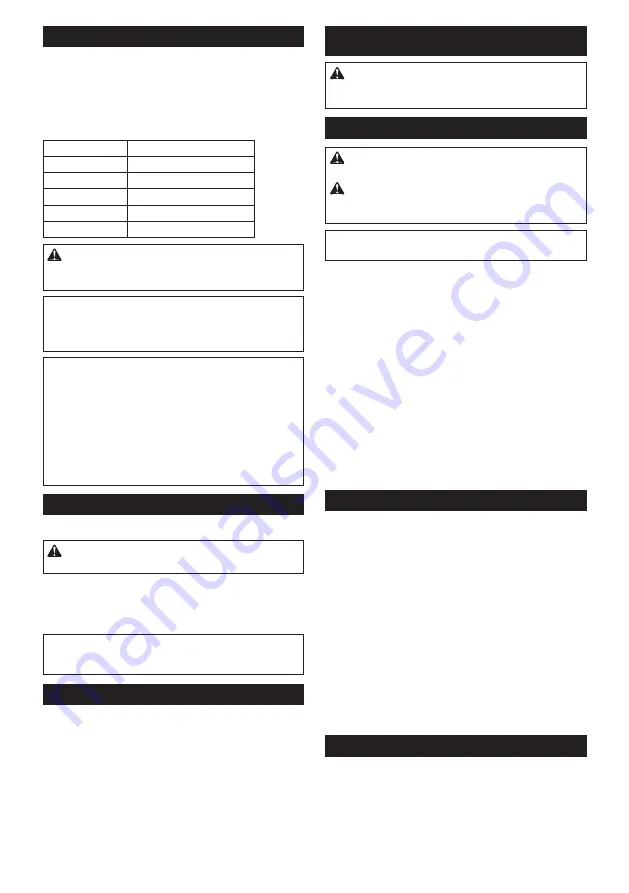
11 ENGLISH
Speed change
►
Fig.4:
1.
Speed adjusting dial
The blows per minute can be adjusted by turning the
adjusting dial.
The dial is marked 1 (lowest speed) to 5 (full speed).
Refer to the table for the relationship between the num
-
ber settings on the dial and the blows per minute.
Number
Blows per minute
5
2,650 min
-1
4
2,500 min
-1
3
2,000 min
-1
2
1,500 min
-1
1
1,300 min
-1
CAUTION:
Do not turn the adjusting dial when
the tool is running. Failure to do so may result in
the loss of control of the tool and cause an injury.
NOTICE:
The speed adjusting dial can be turned
only as far as 5 and back to 1. Do not force it past
5 or 1, or the speed adjusting function may no
longer work.
NOTE:
Soft no-load rotation function
Blows at no load per minute becomes smaller than
those on load in order to reduce vibration under no
load, but this does not show trouble.
Once operation starts with a bit against concrete,
blows per minute increase and reach the numbers as
shown in the table.
When temperature is low, the tool may not have this
function even with the motor rotating.
Lighting up the front lamp
►
Fig.5:
1.
Lamp
CAUTION:
Do not look in the light or see the
source of light directly.
Pull the switch trigger to light up the lamp. The lamp
keeps on lighting while the switch trigger is being pulled.
The lamp goes out approximately 10 seconds after
releasing the switch trigger.
NOTE:
Use a dry cloth to wipe the dirt off the lens of
the lamp. Be careful not to scratch the lens of lamp, or
it may lower the illumination.
Electronic function
The tool is equipped with the electronic functions for
easy operation.
•
Constant speed control
The speed control function provides the constant
rotation speed regardless of load conditions.
•
Soft start
The soft-start function minimizes start-up shock,
and makes the machine start smoothly.
ASSEMBLY
CAUTION:
Always be sure that the tool is
switched off and the battery cartridge is removed
before carrying out any work on the tool.
Installing side handle / side grip
CAUTION:
Always use the side handle / side
grip to ensure safe operation.
CAUTION:
After installing or adjusting the
side handle / side grip, make sure that the side
handle / side grip is firmly secured.
NOTICE:
Do not install the side handle / side grip to
any other area than the designated mounting area.
►
Fig.6:
1.
Mounting area
Side handle
►
Fig.7:
1.
Side handle
2.
Clamp nut
The side handle can be swung in a vertical direction and
secured at any desired position. It can also be adjusted
at eight steps back and forth in a horizontal direction.
Loosen the clamp nut to swing the side handle to a
desired position, and then tighten the clamp nut securely.
Side grip (auxiliary handle)
The side grip can be swung, allowing easy handling of
the tool in any position. Loosen the side grip by turning
it counterclockwise, swing it to the desired position and
then tighten it by turning clockwise.
►
Fig.8:
1.
Side grip
Installing or removing bit
Grease
Clean the shank end of the bit and apply grease before
installing the bit.
Coat the shank end of the bit beforehand with a small
amount of grease (about 0.5 - 1 g). This chuck lubrica
-
tion assures smooth action and longer service life.
►
Fig.9:
1.
Shank end
2.
Grease
Insert the bit into the tool. Turn the bit and push it in until
it engages. After installing the bit, always make sure that
the bit is securely held in place by trying to pull it out.
►
Fig.10:
1.
Bit
To remove the bit, pull the chuck cover down all the way
and pull the bit out.
►
Fig.11:
1.
Bit
2.
Chuck cover
Bit angle
The bit can be secured at 12 different angles. To change the bit
angle, slide the change ring forward, then turn the change ring to
change the bit angle. At the desired angle, slide the change ring
back to the original position. The bit will be secured in place.
After changing the bit angle, make sure the angle is
fixed by trying to rotate the bit.
►
Fig.12:
1.
Change ring
Summary of Contents for HM001GM201
Page 2: ...1 2 3 Fig 1 1 2 Fig 2 1 2 A B Fig 3 1 Fig 4 1 Fig 5 1 Fig 6 1 2 Fig 7 1 Fig 8 2 ...
Page 3: ...1 2 Fig 9 1 Fig 10 2 1 Fig 11 1 Fig 12 1 2 3 Fig 13 1 2 3 Fig 14 1 2 Fig 15 3 ...
Page 4: ...3 2 1 4 Fig 16 1 Fig 17 Fig 18 Fig 19 Fig 20 1 Fig 21 1 2 3 4 Fig 22 4 ...
Page 5: ...1 2 3 Fig 23 1 Fig 24 1 2 1 2 Fig 25 Fig 26 1 Fig 27 5 ...
Page 6: ...1 2 Fig 28 1 Fig 29 1 Fig 30 1 2 1 2 Fig 31 6 ...
Page 114: ...114 ...
Page 115: ...115 ...


























